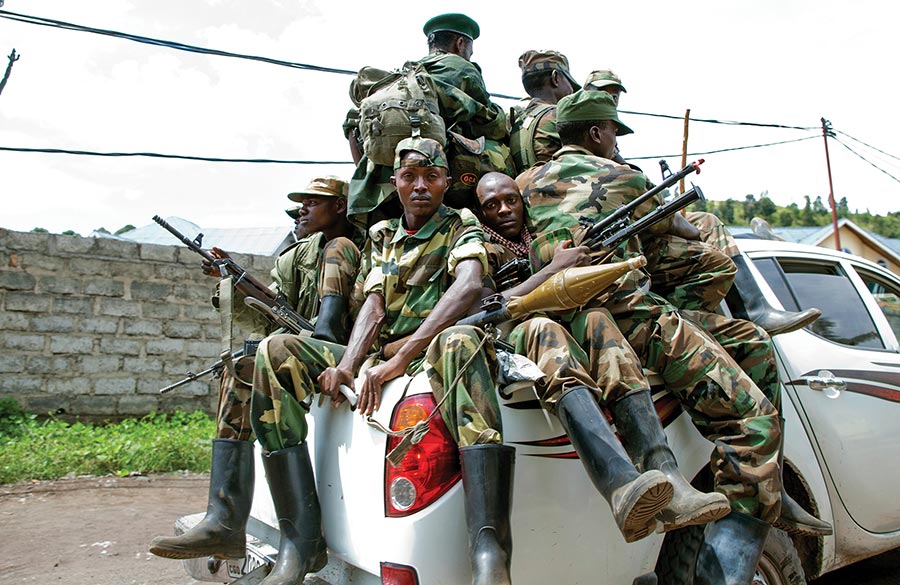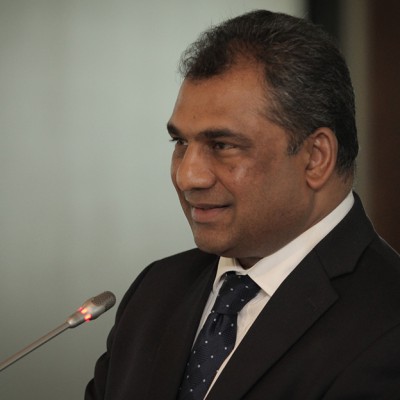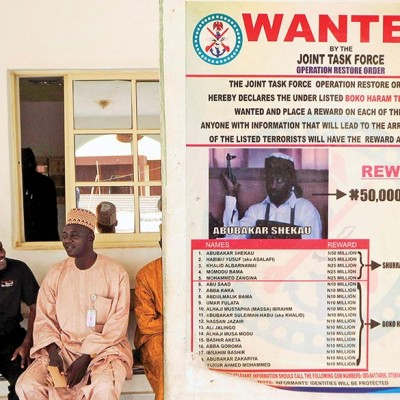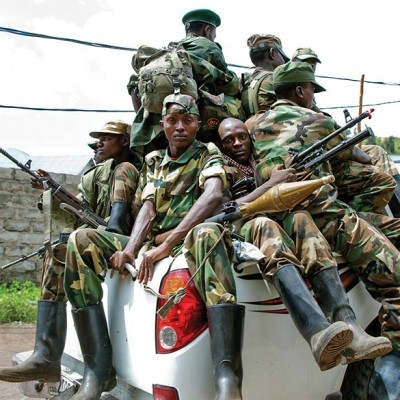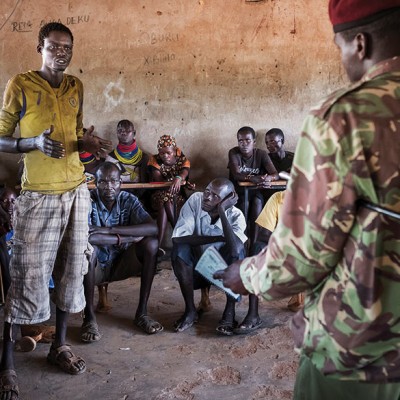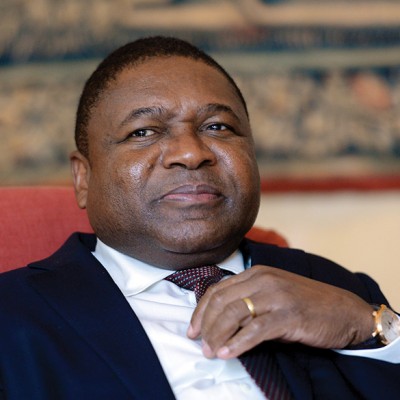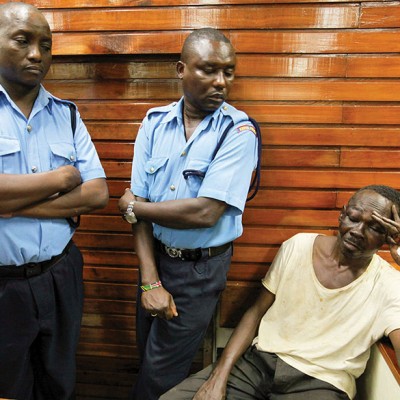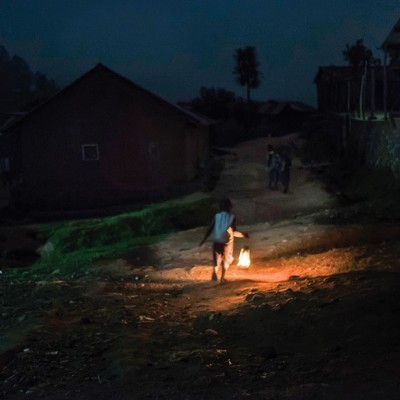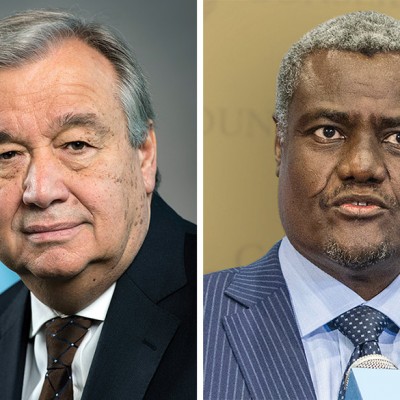Introduction
The province of North Kivu in the Democratic Republic of the Congo (DRC) has seen little respite from conflict in more than two decades. It was here that the ethnic violence that preceded the First Congo War broke out in 1993 and it is here that the conflict continues to the present day. The defeat of the largest rebel group, Mouvement du 23 Mars (M23), in November 2013 has only served to further fragment the armed group landscape, and there are currently more than 70 groups active in the region.1

In 2003, an armistice agreement brought peace to most of the DRC. But the eastern provinces, and particularly North Kivu, remained restive. Why? Most media accounts focus on the illegal exploitation of mineral resources that is thought to generate violence in three ways: national and foreign actors compete for control of the mining sites; groups are able to finance their operations; and groups employ violence against civilians to gain control over resource-rich areas, or the ability to exploit them.2 Indeed, minerals are considered so closely linked to violence they have been dubbed “the engines of chaos”.3
Conflict in North Kivu since 2003
By early 2004, the peace process was already starting to unravel in North Kivu. Under the terms of the deal, all belligerents were to join a transitional government and merge their forces into one national army. However, it quickly became clear that not all parties were fully committed to peace. An early sign of this was the defection of three senior Rally for Congolese Democracy (RCD) officers – among them Laurent Nkunda – to form a political movement that morphed into the National Congress for the Defence of the People (CNDP) rebellion in July 2006. The region was once again plunged into turmoil, with fighting reaching the intensity of the Second Congo War.4 Whilst Mai Mai (self-defence militias) were responsible for some of this violence, the struggle between the CNDP and the Forces démocratiques de libération du Rwanda (FDLR) – the largest Rwandan Hutu group – was at its heart.
The CNDP captured substantial territory in North Kivu and took steps to establish alternative administration structures. A police force was set up, some school fees and health bills paid and communal labour organised to repair the roads. Money was raised by exacting taxes on “everything from small kiosks to mining and the charcoal trade”.5 Unable to defeat the CNDP militarily, DRC authorities struck a deal with Rwanda (backers of the CNDP and providers of protection for the group’s leader, Nkunda) that brought the rebellion to a sudden end in late 2008.
Under new leadership, the CNDP signed a peace accord in Goma in March 2009, which allowed the group to keep its command structures in place. When moves were made to dismantle these, a splinter group launched the M23 rebellion in May 2012. A series of offences captured the territorial capital of Rutshuru, the Bunagana border and the military base of Rumangabo. This run of success swelled M23’s ranks and it took steps to legitimise itself by strengthening its political wing, setting up a tax collection network and liaising with humanitarian workers in the areas under its control.6
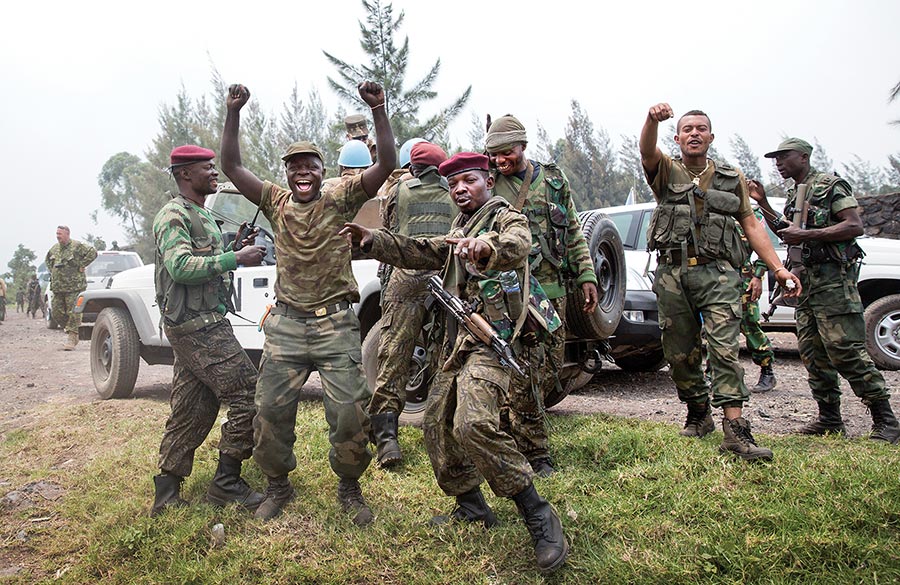
In November 2012, M23 occupied Goma. But the occupation, along with the publication of a report by the United Nations (UN) Group of Experts, put the spotlight on the support M23 was receiving from Rwanda. Several Western countries, including the United States (US), suspended financial aid to Rwanda – and Rwanda, in turn, cut its support to M23. Peace talks began, but were conducted in only a desultory manner by both sides. However, the talks did precipitate a split in M23, whose leadership was divided over what position to take. In late October 2013, following suspension of the peace talks, the DRC army, assisted by the Intervention Brigade and UN troops, launched a successful offensive. Within two weeks, the rebel group had been driven from all its strongholds in North Kivu and completely defeated.7
Challenging the Narrative
The economic dimensions of civil war and the existence of a “resource curse” have been of keen interest to researchers since the late 1990s. Paul Collier8 was the first to draw an explicit link between reliance on primary commodities and the onset of civil war, theorising that belligerents entered into conflicts to benefit materially. Rebel movements might identify themselves in terms of grievances, but in reality these were little more than self-serving justifications. Later work qualified the initial theory by emphasising the role of feasibility: civil war is still caused by greed, but mostly likely will occur in environments where an economic base can sustain it.9 There is no place in the feasibility hypothesis for the idea that rebellion can be a legitimate response to state criminality. In North Kivu, state officials in some capacity have been responsible for most human rights violations. This sanctioned criminality has exacerbated the already massive social and economic inequalities and created “genuine and extreme grievances”.10
In addition to the feasibility perspective, it has been theorised that the availability of natural resources shapes the dynamics of rebel movements. There are two aspects to this. First, resource riches enable groups to recruit on the basis of short-term rewards. This leads to the ranks being swelled by opportunistic joiners who have little commitment to the cause. Second, economically motivated leaders will gradually come to the fore. Whilst the evidence that fighters join for financial reasons remains tentative, the tendency for groups to favour economic motivations over time has more empirical backing. The process of “economisation” – whereby groups gradually reorient towards profiting from the opportunities opened up by war – was one of the defining features of the Second Congo War.11
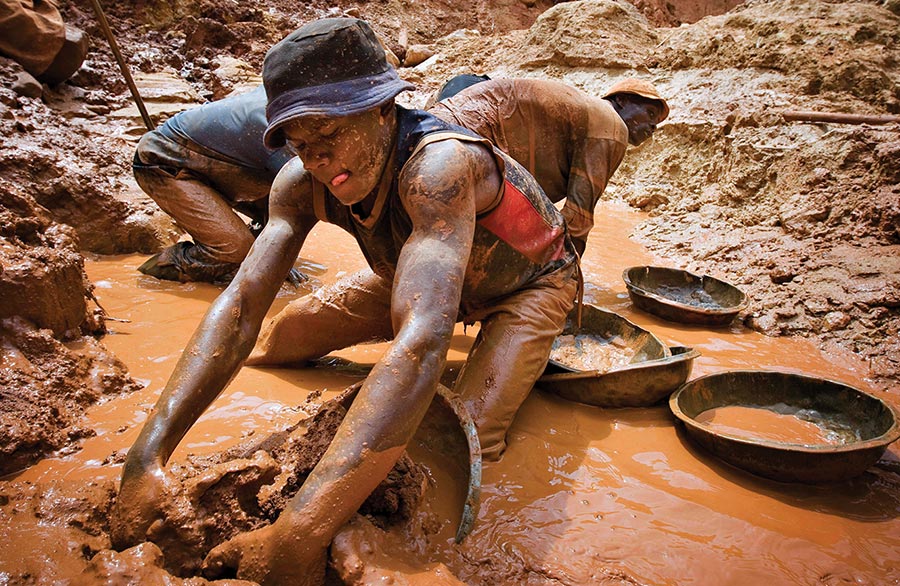
The CNDP is thought to have earned only 15% of its revenue from the mineral trade.12 However, this information must be qualified by recognising that the CNDP seems to be something of an outlier – with other groups, the percentage was far higher. M23 followed a similar pattern. According to an International Peace Information Service (IPIS)13 report, M23 was not involved in the mining sector, and control over minerals was not a priority for the group. During the roughly 18-month period the group was at its peak, it made no attempt to target mining sites, nor did it conduct mineral exports through the areas under its control. The group mainly financed its rebellion by levying taxes on households and transport.14
This does not mean M23 failed to profit from the mineral trade. A significant measure of the group’s transport tax revenue came from the export of coltan and cassiterite across the Goma/Gisenyi border. M23 also had traders in its employ, and benefited from the “liberation” of significant stocks of minerals. The group probably calculated that there was no need for it physically to occupy the mines when it controlled the routes in and out of the region. This could be linked with the mineral being mined: metals like tin, coltan and wolframite are only valuable in bulk and therefore can be taxed easily at border crossings or on roads. Direct control of diamond and gold mines could be more important. Furthermore, fieldwork and research has shown that while only a small number of sites are under the direct control of armed groups, all levels of the mineral supply chain are vulnerable to exploitation.15
Whilst both the CNDP and M23 made money from mineral resources, it was not their primary motivation or their main source of income. The measure of popular support they had, along with the fact they were strong enough to control territory, meant that taxation and transport taxes made up the bulk of their income. These two forms of income are not unconnected to the mineral trade, so it would be unwise to make any sweeping claims. However, the impact of the mining embargo seems to support Johnson’s assertion that the “the existence of a trade in minerals is not a factor favouring either conflict or its absence in North Kivu”.16 This dynamic is clear when the trajectory of the trade in coltan is considered. Whilst a price boom in the early 2000s led many groups to finance their operations by trading in coltan, once the price of the mineral dropped, it returned to being just one of many income streams, which included everything from gold and tin to wildlife and theft of consumer goods.17
Field research by Laudati18 draws attention to the predatory and informal “economy of violence” that has taken root in the region. Roadblocks, the levying of taxes, profits from forest resources (charcoal, timber and hemp), the pillaging of livestock and organised theft all contribute to the income of the various rebel groups.
Income is also generated from non-mineral goods that form the basis of the everyday economy. No activity, no matter how low level, escapes predation, and products as seemingly small as milk, cheese and palm oil are also targeted.

There is a widespread perception that the CNDP and M23 were Rwandan proxies created to continue the profiteering that began in earnest during the Second Congo War. Although Rwanda remains deeply involved with mining activities in North Kivu, security concerns rather than economic interests are the primary motivation.19 The most pressing of these concerns is the continued presence of FDLR remnants in the area. There is also a general distrust of the DRC government, which is viewed as weak, corrupt and unable to keep order in its eastern territories.
That being said, the support M23 received from the Rwandan government has been well documented. According to testimony given to Stearns20 by Ugandan officials and former M23 members, Rwanda was involved with the group from its inception. The UN Group of Experts21 reported that the Rwandan government provided direct military support, “facilitating recruitment, encouraging and facilitating desertions from the armed forces of the DRC, and providing arms, ammunition, intelligence and political advice.”
Conclusion
Since the end of the 1990s, non-governmental organisations (NGOs) such as Global Witness have campaigned for anti-“conflict-minerals” initiatives and legislation, on the grounds that profits from these minerals fuel conflicts. These campaigns led to the creation of a UN Panel of Inquiry – which, in turn, led to a raft of legislation being passed or projects being set up to reform the mining sector.22 In July 2010, the US Dodd-Frank Act was passed and, shortly afterwards, the DRC government suspended mining in the eastern provinces in what amounted to a de facto embargo on minerals emanating from the Kivus. However, the ban did not have the result intended. Armed groups seemed barely effected by the loss of income from minerals, quickly diversifying their income streams.23
The Congo wars had a devastating effect on the DRC economy. Agricultural communities were devastated, and the scarcity of land means young men cannot turn to farming. Large-scale criminal operations remain widespread. However, the assumption of “greed” prevalent in some theories of resources and conflict is inaccurate. For most of those involved, the mineral trade is simply a way to get by in a society where poverty is endemic.
Although natural resources did not cause the wars in the DRC, there was a progressive “economisation” whereby the violence became increasingly motivated by profit.24 By the end of the Second Congo War, this pattern was established and powerful people were making a great deal of money. It would be tempting to see the CNDP and M23 rebellions as a continuation of this process. Both were “top-down” rebellions that began as army mutinies, and the enrichment of these movement’s leaders is well documented.25 We can perhaps see evidence of Weinstein’s theory of a “resource curse” within the dynamics of a rebel movement in the trajectory of the CNDP and M23. The first M23 mutiny collapsed after a few days, with most ex-CNDP troops returning to the army. Reportedly, the soldiers were tired of seeing their commanders get rich.
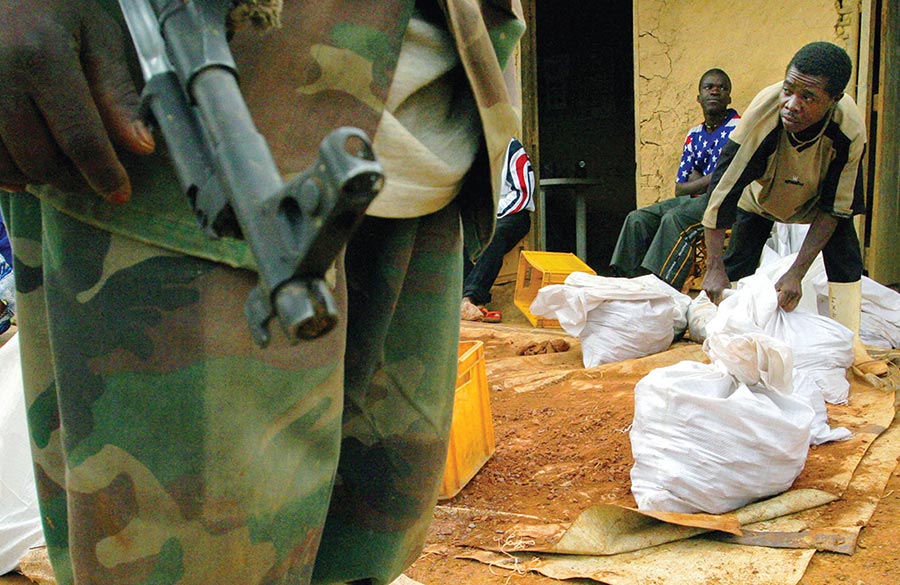
Although rebel groups use these resources to fund their operations, it does not follow that they are the driving force of the conflict. If this were the case, military activities would focus on establishing direct control over resource-rich areas. This has not been the case in North Kivu, where there has been no fighting around control of significant mining sites.26 It is also true that the Grand Nord part of the region has seen far less violence, despite being home to the gold and diamond mining sites that resource theory suggests rebels would find most attractive.27
It is clear that minerals have been a powerful factor in the conflicts, but the exact relationship between North Kivu’s resource wealth and the waging of war is harder to decipher than mainstream discourse captures. Le Billon28 notes that primary commodities are “highly amenable to taxing and looting” and therefore a means of “escalating and prolonging” conflict. But whilst both M23 and CNDP made money from mineral resources, it was not their primary motivation or their main source of income. The rebellions were about demographics, citizenship and land rights and were fuelled not by greed but by the belief that the DRC government was not able or willing to protect the Tutsi community.29 The existence of a thriving mineral trade is not, in the words of Dominic Johnson, “a factor favouring either conflict or its absence in North Kivu.”30 It is therefore crucial that attempts to reach a better understanding of violence in the region focus on political and social causes, rather than economic ones.
Endnotes
- Stearns, Jason, Verweijen, Judith and Baaz, Maria Ericksson (2013) The National Army and Armed Groups in Eastern Congo: Untangling the Gordian Knot of Insecurity. Rift Valley Institute.
- Autesserre, Séverine (2010) The Trouble with the Congo: Local Violence and the Failure of International Peace-building. Cambridge: Cambridge University Press, p. 42.
- Katunga, John (2007) ‘Minerals, Forests, and Violent Conflict in the Democratic Republic of Congo’, ECSP Report, 12, Available at: <https://www.wilsoncenter.org/sites/default/files/Katunga12.pdf> [Accessed 1 March 2017].
- Stearns, Jason (2012a) North Kivu: The Background to Conflict in North Kivu Province of Eastern Congo. Rift Valley Institute, p. 39.
- Autesserre, Séverine (2010) op. cit., p. 16.
- Stearns, Jason (2012b) From CNDP to M23: The Evolution of an Armed Movement in Eastern Congo. Rift Valley Institute, p. 45.
- Koko, Sadiki (2014) The Mouvement du 23 Mars and the Dynamics of a Failed Insurgency in the Democratic Republic of Congo. South African Journal of International Affairs, 21(2), pp. 261–278.
- Collier, Paul (2000) Doing Well Out of War: An Economic Perspective. In Berdal, Mats and Malone, David (eds) Greed and Grievance: Economic Agendas in Civil War. Boulder: Lynne Reiner Publishers, pp. 99–111.
- Collier, Paul, Hoeffler, Anke and Rohner, Dominic (2006) ‘Beyond Greed and Grievance: Feasibility and Civil War’, Available at: <http://www.csae.ox.ac.uk/workingpapers/pdfs/2006-10text.pdf> [Accessed 1 March 2017].
- Lemarchand, René (2009) The Dynamics of Violence in Central Africa. Philadelphia: University of Pennsylvania Press, p. 58.
- Jackson, Stephen (2002) Making a Killing: Criminality and Coping in the Kivu War Economy. Review of African Political Economy, 29(93–94), pp. 517–536.
- Garrett, Nicholas and Mitchell, Harrison (2009) ‘Trading Conflict for Development: Utilising the Trade in Minerals from Eastern DR Congo for Development’, Available at: <http://www.rcsglobal.com/documents/Trading%20Conflict%20for%20Development.pdf> [Accessed 1 March 2017].
- IPIS (2012) ‘Mapping Conflict Motives: M23’, Available at: <http://ipisresearch.com/publications_detail.php?id=390> [Accessed 1 March 2017].
- UN Group of Experts (2014) Letter Dated 22 January 2014 from the Coordinator of the Group of Experts on the Democratic Republic of the Congo. S/2014/42.
- Radle, Ben and Vogel, Christophe (2015) Fighting Windmills in Eastern Congo? The Ambiguous Impact of the ‘Conflict Minerals’ Movement. The Extractive Industries and Society, 2 (2015), pp. 406–410.
- Johnson, Dominic (2009) ‘Minerals and Conflict in Eastern DRC’, Available at: <http://www.congoforum.be/en/nieuwsdetail.asp?subitem=1&newsid=160264&Actualiteit=selected> [Accessed 18 December 2015].
- Nest, Michael (2011) Coltan. Cambridge: Polity Press, p. 163.
- Laudati, Ann (2013) Beyond Minerals: Broadening ‘Economies of Violence’ in Eastern Democratic Republic of Congo. Review of African Political Economy, 40(135), pp. 34–39.
- Stearns, Jason (2012b) op. cit., pp. 55–57.
- Ibid., p. 144.
- UN Group of Experts (2012) Letter Dated 12 October 2012 from the Group of Experts on the Democratic Republic of the Congo. S/2012/843.
- Autesserre, Séverine (2012) Dangerous Tales: Dominant Narratives on the Congo and Their Unintended Consequences. African Affairs, 111(443), p. 211.
- Bernarding, Nina, Guesnet, Lena and Muller-Kone, Marie (2015) No Rebel Without a Cause: Shifting the Debate about Conflict Minerals in Eastern DRC. 2/2015 Working Paper. BICC, p. 14.
- Jackson, Stephen (2002) op. cit.
- Stearns, Jason (2012b) op. cit., p. 39.
- Johnson, Dominic (2009) op. cit.
- International Alert Report (2010) The Role of the Exploitation of Natural Resources in Fuelling and Prolonging Crises in the Eastern DRC.
- Le Billon, Philippe (2001) The Political Ecology of War: Natural Resources and Armed Conflicts. Political Geography, 20, p. 569.
- Stearns, Jason (2012b) op. cit., p. 9.
- Johnson, Dominic (2009) op. cit.

